Visual Art
A Curious Journey into History Through the Miniatures of Chilean Artist Apia
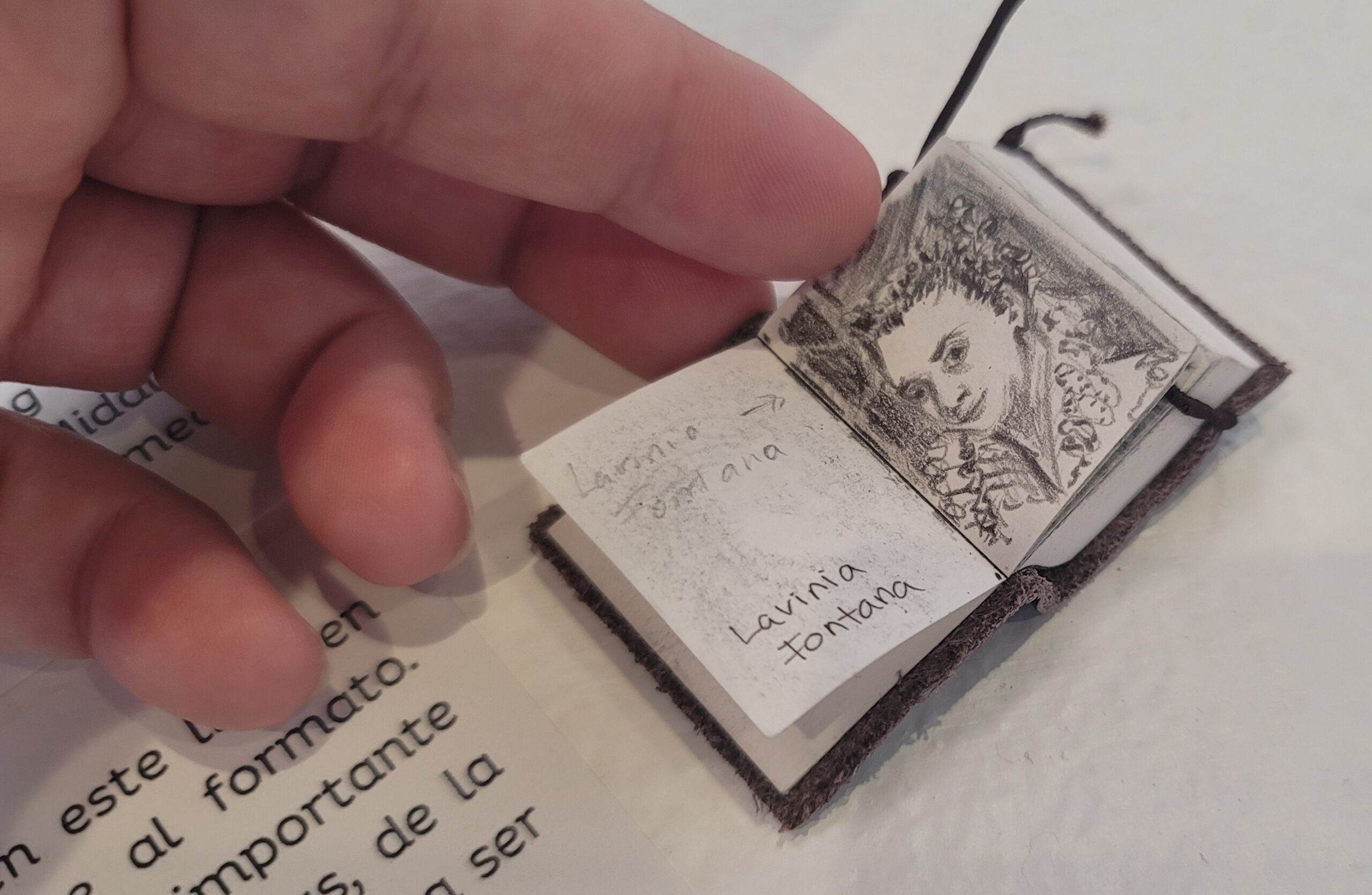
Instead of painting with a loupe, in Apia’s exhibition at the Museum of Contemporary Art of the Americas, she uses the naked eye as the main tool and integrates augmented reality as a revealing device of each of her pieces. (Photo courtesy of the artist)
Miniature art may be minuscule, but the attention to detail is gigantic: each element that constitutes its source of inspiration is reproduced on a smaller scale, making the piece fit in the palm of a hand without losing its essence. Miami’s Museum of Contemporary Art of the Americas is hosting an exhibition dedicated to the work of Chilean artist Apia (real name Carolina V. Garcia) and to whom miniatures are a powerful way of artistic expression. Under the title “Exaggerations of History,” the exhibition is curated by Jorge Rodríguez Díez, executive director and chief curator of MoCAA.
“I consider myself a multidisciplinary conceptual artist,” says Apia. “I am driven by the theme of inclusion, and I develop works and projects in which environments are created that serve to start a conversation. In this case, I saw a big gap in the knowledge of women artists and wanted to start that debate — All with the intention of including them in today’s life,” says the 46-year-old who has lived in Miami since 2006.
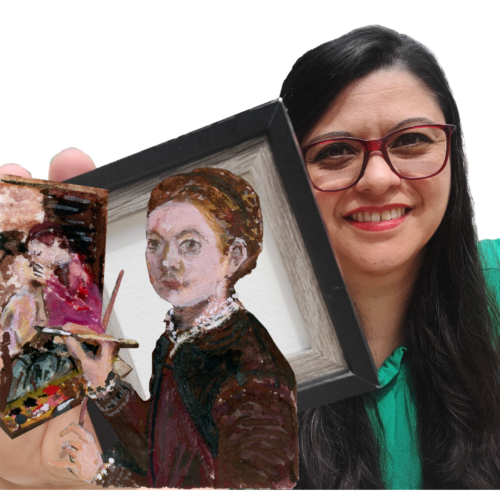
Chilean artist Carolina V. Garcia, who goes by the name Apia, is shown with one of the works in “Exaggerations of History” at the Museum of Contemporary Art of the Americas, Kendall. (Photo courtesy of the artist)
And why work in the format of miniatures? The creator acknowledges in her artist statement that with the show she is paying homage to a genre historically dominated by women. She acknowledges artist Sofonisba Anguissola (born in 1532, Italy), who she says inspired the series and is an “exquisite painter of the Renaissance and one of the earliest known female artists to establish a prestigious international reputation.”
Apia says that the tiny size, smaller than traditional miniatures, was intentionally chosen to add a physical component for the viewer. To fully appreciate the works, the observer must get up close and personal with the artwork.
Also, instead of painting with any magnifying tool (usually used in creating these types of works) Apia uses the naked eye as the main tool, and she also integrates augmented reality in the display as a revealing device of each of her pieces. According to her, this embodies the concept of inclusion, which she used to “reintroduce these artists into contemporary discourse. It was imperative to present their lives and works in a way that was appealing and welcoming to a broad audience.”
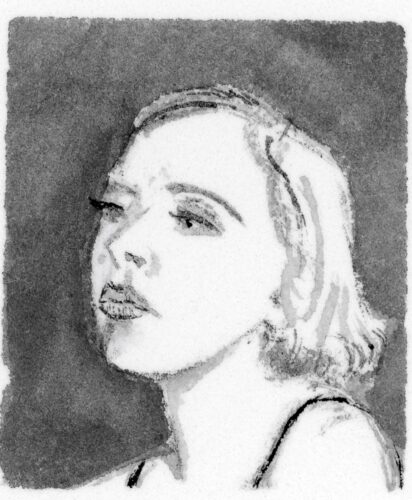
Miniature portrait of Polish painter Tamara de Lempicka. 1x 7/8 inches. Water soluble graphite. (Photo courtesy of the artist)
Reading the stories of the female creators from different historical periods, it is impossible for Apia not to feel motivated to break certain barriers, she says. “I felt that this message was very important and should see the light. I thought a lot about how to shape it, from the visual to the physical component. I wanted to provoke in the visitor an invitation to approach, to take the time, to interact and also to greet each one of them. That’s why each miniature is placed at the height it is (exactly 54 inches),” she says
For his part, the curator of the exhibition explains how the selection of such works was intrinsically linked to the essence of the institution’s mission. “When we were made aware of the series ‘Exaggerations of History’ we saw a remarkable resonance with our goal. Not only because Apia is a female artist actively engaged in her practice, but also because her work highlights and honors the legacy of 101 female artists throughout history. From the 12th to the 20th century, Apia documents and celebrates the immense contribution these women have made to the development of art through time,” says Rodriguez Diez.
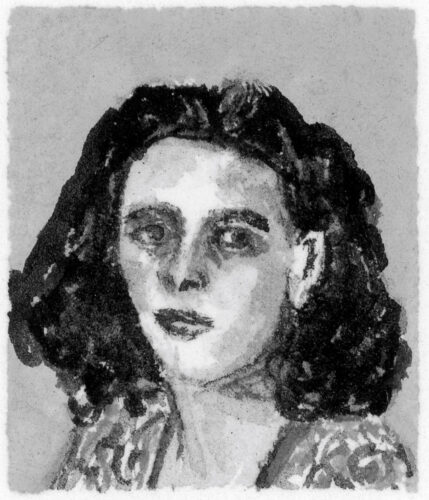
Miniature portrait of British-born surrealist painter and novelist Leonora Carrington. 1x 7/8 inches. Water soluble graphite. (Photo courtesy of the artist)
The curator states that Apia’s approach to her pieces coincide with the overall purpose of the museum of revisiting and revising history as much as possible to correct biased narratives. “For too long, women artists have been underrepresented in art history, with many of their past contributions ignored or minimized. An exhibition that pays tribute to these artists redresses this historical imbalance, highlights their achievements and gives them belated but more than deserved recognition,” says the curator.
Apia discloses what led her to use art as a way to communicate her thoughts and ideas, having studied a completely different career. “I didn’t study art formally, I never took classes, but I was always creating things, drawing, painting and learning how to use media, taking note of how they behave”.
Apia assures that she was concerned with intensely and carefully observing the colors, shapes, geometry behind things, the light, the reflections, everything.
“At 12, I spent a whole summer with a small mirror to analyze the details of my face in order to learn how to draw faces. I discovered the relationship between the pupils and the corners of the mouth, the nose and the ears. And by observing those details, I learned how to draw. After that summer, I could ‘copy’ anything, and it was transformative. Because of my dedication, everyone thought I would study art. But in a practical decision, knowing how art worked in Chile, and thinking about my economic independence, I studied engineering,” she says.
On the leitmotif of her career, she says: “I create spaces for conversations around complex issues, and for several years now that focus has been around inclusion. This ranges from touching on specific and known issues where it is needed, to analyzing the aspects of the individual that make it possible. I focus on the different aspects of the process, from the human as an individual to the social being that shares both physical and mental space with others.”
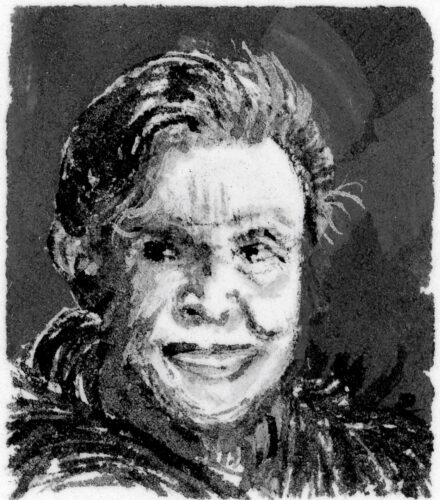
Miniature Portrait of French-American artist Louise Bourgeois.
7/8 x 3/4. Water soluble graphite. (Photo courtesy of the artist)
The exhibition was a challenging one, not only for the artist but also for the curator, mostly in the process of establishing a structure for the works in the space and creating the dialogue between them. “Apia was in charge of the selection, with meticulous research that defined the group of women who make up the series,” says Rodriguez Diez. “Her first guideline was the availability of visual references, essential for the elaboration of vivid portraits. Then, her criteria leaned toward excellence, prioritizing the inclusion of the most outstanding female artists in the history of Western art. Subsequently, the museum carried out a second review, taking into account that only 50 of these miniatures would be presented in the exhibition hall.”
On memory as a fundamental tool in her work, Apia says: “Things are not created in a vacuum. The roots of the project are very important to me. From those processes other processes are born . . .other explorations. Showing them is also important to me. It brings the audience closer to the creative process, and somehow I feel I invite them to participate in the work in a more inclusive way by doing so.”
The Museum of Contemporary Art of the Americas—formerly the Kendall Art Center—is currently immersed in a process of solidifying a new path to become a cultural destination in a community where a museum like this one, with the quality and rigor of others in the Miami arts circuit, was needed, according to Rodriguez Diez. That is why, in tandem with Apia’s exhibition, its two most important collections are also on permanent display: the ceramics collection, which has been shown as part of events such as the 57th Annual NCECA Conference in Cincinnati. Also the bronze sculpture collection, an ambitious project that includes works of artists like Luis Cruz Azaceta, Ivonne Ferrer, Carlos Enrique Prado, Noel Dobarganes, Néstor Arenas, Ciro Quintana, Reynerio Tamayo and Esterio Segura. All in addition to a busy schedule with a long queue of new shows for the remainder of 2024.
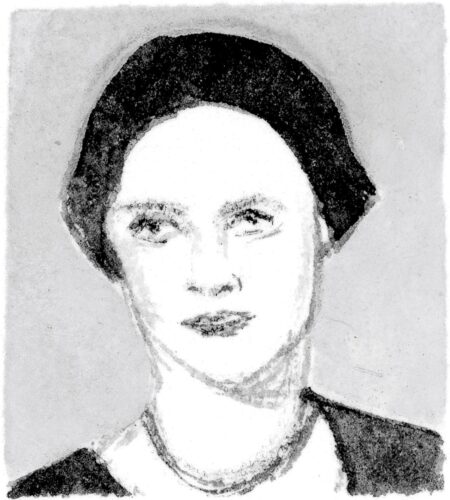
Miniature portrait of American photographer and photojournalist Lee Miller. 1 x 7/8 inches. Water soluble graphite. (Photo courtesy of the artist)
“Our archives, openly exposed to the public, are evidence that all our exhibitions and cultural activities are conceived, analyzed and approved in terms of their alignment with our objectives as an institution. They are our family album, the photos of our childhood and adolescence as a museum,” he says. “This memory is also an invitation to many other artists who have not yet exhibited with us, to make them feel at home in our space. In short, they perceive that in us they can find a community environment because we are moved by the passion they put into each project.”
WHAT: “Exaggerations of History” with works by Chilean artist Apia
WHEN: Weekdays and Saturdays from 9 a.m. to 5 p.m., Sundays by appointment. Through May 3.
WHERE: The Museum of Contemporary Art of the Americas, 12063 SW 131st Ave., Miami
COST: Free
INFORMATION: 786-624-0182; 786-794-3699 or mocaamericas.org
ArtburstMiami.com is a nonprofit media source for the arts featuring fresh and original stories by writers dedicated to theater, dance, visual arts, film, music and more. Don’t miss a story at www.artburstmiami.com.
